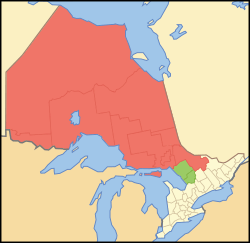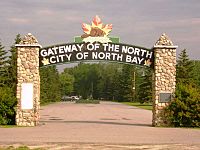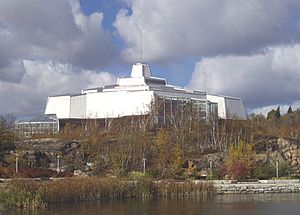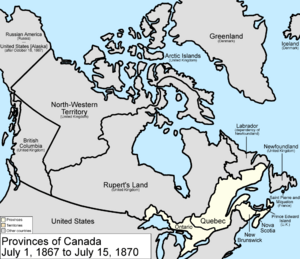Northern Ontario facts for kids
Quick facts for kids
Northern Ontario
Nord de l'Ontario (French) |
|
|---|---|
|
Primary Region
|
|

██ Statistical area (geographic area north of French River) ██ Extended administrative area |
|
| Country | |
| Province | |
| Area | |
| • Total | 806,707.51 km2 (311,471.51 sq mi) |
| Population
(2021)
|
|
| • Total | 789,519 |
| • Density | 1/km2 (3/sq mi) |
| Largest city | Greater Sudbury 166,044(2021) |
| Highest point | Ishpatina Ridge (693 m) |
| Longest river | Albany River (980 km) |
| Government of Ontario
List of MPs
Charlie Angus
Patty Hajdu Carol Hughes Viviane Lapointe Eric Melillo Anthony Rota Marcus Powlowski Marc Serré Terry Sheehan List of MPPs
Gilles Bisson
Guy Bourgouin Vic Fedeli France Gélinas Michael Gravelle Sol Mamakwa Michael Mantha Judith Monteith-Farrell Greg Rickford Ross Romano John Vanthof Jamie West |
|
Northern Ontario is a huge and important part of the Canadian province of Ontario. It's different from Southern Ontario, which is the other main part of the province. Most of Northern Ontario sits on a very old, rocky area called the Canadian Shield. This area is mostly north of Lake Huron, the French River, Lake Nipissing, and the Mattawa River.
This large region covers about 88% of Ontario's land. That's about 806,000 square kilometers! But only about 780,000 people live here. This means it's very spread out, with lots of nature. The weather here can be extreme, with very cold winters and hot summers. The main jobs in Northern Ontario are in mining, forestry, and making hydroelectricity (power from water).
For some purposes, Northern Ontario is split into two parts: Northeastern and Northwestern Ontario. The western districts like Rainy River, Kenora, and Thunder Bay are "Northwestern Ontario." All the other districts are "Northeastern Ontario." Most of the people in Northern Ontario live in the Northeastern part.
In the early 1900s, Northern Ontario was sometimes called "New Ontario." In French, it can still be called Nouvel-Ontario, but le Nord de l'Ontario is more common now.
Contents
How Northern Ontario Grew
Long ago, parts of what is now Northern Ontario were part of New France. After 1763, these areas became British. Later, they were part of Upper Canada and then the Province of Canada.
When Canada became a country in 1867, the southern part of Northern Ontario was already part of Ontario. But the northernmost part was a British territory called Rupert's Land. Over time, Ontario's borders grew. In 1884, it was decided that the Lake of the Woods area belonged to Ontario. By 1889, Ontario's northern border reached the Albany River.
The very northern tip of the province, from the Albany River all the way to Hudson Bay, was added in 1912. This area was first called the District of Patricia. Later, in 1937, it became part of the Kenora District.
How Northern Ontario is Organized
The province started creating special areas called "judicial districts" in Northern Ontario in 1858. These districts helped provide legal and administrative services. Unlike the counties in Southern Ontario, these districts don't have their own local governments. This is because there aren't enough people to support a full county government. So, many services are provided directly by the provincial government. For example, the province maintains the main roads.
The districts in Northern Ontario are Rainy River, Kenora, Thunder Bay, Cochrane, Timiskaming, Algoma, Sudbury, Nipissing, and Manitoulin. The city of Greater Sudbury is special because it handles its own local services, like a county would.
Sometimes, for administrative reasons, the districts of Muskoka and Parry Sound are also grouped with Northern Ontario, even though they are geographically further south.
Most of Northeastern Ontario is in the Eastern time zone (UTC −5). Northwestern Ontario is split between the Eastern and Central (UTC −6) time zones.
Communities in Northern Ontario

Northern Ontario has nine cities. Here they are, from largest to smallest by population in 2021:
| Name of city | Population | CMA/CA population | CMA/CA |
|---|---|---|---|
| Greater Sudbury | 166,004 | 170,605 | CMA |
| Thunder Bay | 108,843 | 123,258 | CMA |
| Sault Ste. Marie | 72,051 | 76,731 | CA |
| North Bay | 52,662 | 71,736 | CA |
| Timmins | 41,145 | 41,145 | CA |
| Kenora | 14,967 | 14,967 | CA |
| Elliot Lake | 11,372 | 11,372 | CA |
| Temiskaming Shores | 9,634 | N/A | |
| Dryden | 7,388 | N/A |
It's interesting that in Ontario, towns don't have to be a certain size to become a city. So, some towns in Northern Ontario actually have more people than the smallest city, Dryden.
Before 2001, Thunder Bay had more people than the old city of Sudbury. But when Greater Sudbury was created, it became the largest city and the largest "Census Metropolitan Area" (a big city area) in the region.
Towns
Here are some other towns in Northern Ontario:
| Name of Town | Population (2021) | Population (2016) | Population percentage change, 2016 to 2021 |
|---|---|---|---|
| West Nipissing | 14,583 | 14,364 | 1.5 |
| Kapuskasing | 8,057 | 8,292 | -2.8 |
| Kirkland Lake | 7,750 | 7,981 | -2.9 |
| Fort Frances | 7,466 | 7,739 | -3.5 |
| Parry Sound | 6,879 | 6,408 | 7.4 |
| Oliver Paipoonge | 6,035 | 5,922 | 1.9 |
| Cochrane | 5,390 | 5,321 | 1.3 |
| Sioux Lookout | 5,839 | 5,272 | 10.8 |
| Hearst | 4,794 | 5,070 | -5.4 |
| Espanola | 5,185 | 4,996 | 2.7 |
| Greenstone | 4,309 | 4,636 | -7.1 |
| Iroquois Falls | 4,418 | 4,537 | -2.6 |
| Red Lake | 4,094 | 4,107 | -0.3 |
Economy and Jobs

Greater Sudbury is the biggest city in Northeastern Ontario, and Thunder Bay is the biggest in Northwestern Ontario. These two areas are quite different in their economies and cultures. They are far apart, so neither city is the "main" economic center for all of Northern Ontario.
Each city has its own strengths. Sudbury has a larger economy because its area has more people. Thunder Bay benefits from being a hub for air, train, and ship travel. Its airport is the third busiest in Ontario. Sudbury's economy is more varied, with many jobs in education and health care. Thunder Bay's economy still relies a lot on natural resources and manufacturing.
Northern Ontario has sometimes struggled to keep its economy and population strong. Many cities lost people between 1996 and 2001. Most communities here depend on natural resources like mining and forestry. These industries can have "boom and bust" cycles, meaning they are strong sometimes and weak at other times. After 2001, the larger cities started growing again, but many smaller towns continued to shrink.
The cities have also relied on government jobs and investments. The government has moved some of its offices and agencies to Northern Ontario. Many major tourist spots, like Science North in Sudbury, are also supported by the government.
Recently, there's been new interest in mining. Places like McFaulds Lake are being explored for diamonds and other minerals. New mining sites are also being looked at in Sudbury, Timmins, and other areas. This could bring more jobs and money to the region.
Education in Northern Ontario
Northern Ontario has five universities:
- Lakehead University in Thunder Bay
- Laurentian University in Sudbury
- Nipissing University in North Bay
- Algoma University in Sault Ste. Marie
- Université de Hearst in Hearst, Kapuskasing, and Timmins
The region also has six colleges:
- Confederation College in Thunder Bay
- Sault College in Sault Ste. Marie
- Northern College in Timmins
- Canadore College in North Bay
- Cambrian College (English) in Sudbury
- Collège Boréal (French) in Sudbury
Many colleges also have smaller campuses in other towns. There's also Contact North, a network that helps people in small and remote communities get an education from a distance.
The Northern Ontario School of Medicine opened in 2005. It's a special medical school focused on rural medicine. In 2011, Sudbury got the McEwen School of Architecture, and Thunder Bay got the Bora Laskin Faculty of Law. These were the first new schools of their kind in Ontario in many years.
Culture and Fun
Outdoor activities are very popular all year round in Northern Ontario. In summer, people love to go fishing, boating, canoeing, ATVing, and camping. Hunting is popular in the fall, especially for moose and deer. In winter, snowmobiling, ice fishing, cross-country skiing, and snowshoeing are favorite pastimes. The region has many snowmobile trails, and you'll see ice fishing huts on frozen lakes.
Northern Ontario hosts many cultural events. Some big ones include Sudbury's La Nuit sur l'étang (a French music festival), Northern Lights Festival Boréal (a folk festival), and Cinéfest (a film festival). Many communities have festivals celebrating local groups like French, Métis, First Nations, Finnish, and Italian people. Other towns celebrate their unique local history, like Kapuskasing's Lumberjack Days. Even the smallest First Nations communities have an annual pow wow, which is a special gathering. The biggest pow wow is in Wiikwemkoong on Manitoulin Island. In winter, many towns have winter carnivals, like Sault Ste. Marie's Bon Soo Winter Carnival.
There isn't one single "Northern Ontario" food. Fish and wild game, like walleye (pickerel) and moose, are popular. Roadside chip trucks are common, and almost every community has one. Poutine, a dish with fries, cheese curds, and gravy, is a favorite at these places.
Italian food has influenced Northeastern Ontario, with porchetta being a special dish in Sudbury and Sault Ste. Marie. Thunder Bay has a unique Finnish food culture, and the Hoito restaurant is famous for its Finnish pancakes. Chinese Canadian restaurants have been in Northern Ontario for a long time.
While not everywhere, maple syrup is made in some areas near North Bay, Sudbury, Manitoulin Island, and Sault Ste. Marie. St. Joseph Island is especially known for its maple syrup.
After a big local brewery closed in 2006, many new local craft brewers have started up across the region.
Sports in Northern Ontario
Many sports are played here, but ice hockey and curling are the most popular. Almost every community has a hockey rink and a curling rink. Northern Ontario is unique because it sends its own curling teams to national championships like the Tim Hortons Brier and the Scotties Tournament of Hearts. Hockey is often played on outdoor rinks or frozen lakes.
Three teams play in the Ontario Hockey League (a major junior league): the North Bay Battalion, Sault Ste. Marie Greyhounds, and Sudbury Wolves. There are also other junior hockey leagues.
Universities like Algoma Thunderbirds, Lakehead Thunderwolves, Laurentian Voyageurs, and Nipissing Lakers compete in university sports.
The Thunder Bay Chill soccer teams play in a North American league.
Northern Ontario has hosted big sports events, including the 1981 Canada Summer Games and the 2003 Continental Cup of Curling. In 2018, the Sudbury Five basketball team started playing in the National Basketball League of Canada.
Media in Northern Ontario
When it comes to TV, CTV and Global are the main networks you can watch across Northern Ontario. Other channels like CBC Television are mostly available through cable. In the northeast, the four CTV Northern Ontario stations have local studios.
Daily newspapers in the region include the Sudbury Star, the Chronicle-Journal in Thunder Bay, and the Sault Star in Sault Ste. Marie. There are also many local community newspapers.
Magazines published in the region include HighGrader and Northern Ontario Business.
Most commercial radio stations are owned by big national companies. CBC Radio One has stations in Sudbury and Thunder Bay, with smaller stations in other towns. The French Ici Radio-Canada Première also has a station in Sudbury that reaches many parts of Northern Ontario.
Cable TV is provided by different companies depending on where you live.
People and Languages
Many francophone (French-speaking) people moved to Northeastern Ontario during the mining boom in the early 1900s. French is still widely spoken there. Even though Ontario doesn't officially have French as a language for the whole province, the government provides full services in French to anyone who needs them. In 2011, about 24.6% of the people in Northern Ontario spoke both English and French.
The government of Canada treats French and English equally. In 2011, about 10.2% of people in Northern Ontario spoke French most often at home, mostly in Northeastern Ontario.
In 2016, the population of Northern Ontario was 780,140. The average age in 2011 was 43.9 years old. About 5.8% of the population were immigrants.
The region also has a large First Nations population. The main groups are the Ojibwe, Cree, and Oji-Cree nations. There are also smaller communities of Nipissing, Algonquin, Odawa, and Saulteaux people.
In 2016, Northwestern Ontario was mostly white (71%) and Indigenous (26.2%). Northeastern Ontario was mostly white (82.5%) and Indigenous (15%).
In 2001, Catholicism was the most common religion in Northern Ontario (50.8%).
Here are the languages with at least 1,000 native speakers in Northern Ontario in 2011:
| 2011 | % | 2006 | % | ||
|---|---|---|---|---|---|
| 1. | English | 533,980 | 73.94% | 525,230 | 70.98% |
| 2. | French | 125,675 | 17.40% | 131,450 | 17.76% |
| 3. | Italian | 11,245 | 1.56% | 14,560 | 1.97% |
| 4. | Ojibwe | 10,570 | 1.46% | 10,655 | 1.44% |
| 5. | Oji-Cree | 6,325 | 0.88% | 6,120 | 0.83% |
| 6. | Finnish | 5,615 | 0.78% | 7,130 | 0.96% |
| 7. | German | 5,125 | 0.71% | 6,275 | 0.85% |
| 8. | Cree | 3,485 | 0.48% | 3,150 | 0.43% |
| 9. | Polish | 2,700 | 0.37% | 3,655 | 0.49% |
| 10. | Ukrainian | 2,475 | 0.34% | 3,950 | 0.53% |
| 11. | Chinese | 1,620 | 0.22% | 1,945 | 0.26% |
| 12. | Dutch | 1,400 | 0.19% | 1,790 | 0.24% |
| 13. | Spanish | 1,140 | 0.16% | 1,035 | 0.14% |
| 14. | Portuguese | 1,100 | 0.15% | 1,395 | 0.19% |
| 15. | Croatian | 945 | 0.13% | 1,160 | 0.16% |
Here are the ethnic origins reported in Northern Ontario in 2016:
| Ethnic Origin (2016) | Population | Percent |
|---|---|---|
| Canadian | 287,835 | 36.9% |
| French | 204,775 | 26.2% |
| English | 185,075 | 23.7% |
| Irish | 142,055 | 18.2% |
| Scottish | 138,470 | 17.7% |
| First Nations | 104,945 | 13.5% |
| German | 74,195 | 9.5% |
| Italian | 62,405 | 8.0% |
| Ukrainian | 42,795 | 5.5% |
| Métis | 37,290 | 4.8% |
| Finnish | 33,490 | 4.3% |
| Polish | 28,160 | 3.6% |
| Dutch (Netherlands) | 23,340 | 3.0% |
| Swedish | 15,905 | 2.0% |
| British Isles, n.i.e. | 13,340 | 1.7% |
| Welsh | 11,145 | 1.4% |
| Norwegian | 10,075 | 1.3% |
Religion in Northern Ontario at the 2001 census:
| Religion | People | % |
|---|---|---|
| Total | 729,210 | 100 |
| Catholic | 370,305 | 50.8 |
| Protestant | 241,145 | 33.2 |
| No Religion | 95,610 | 13.2 |
| Other Christians | 11,825 | 1.6 |
| Other Religions* | 3,540 | 0.5 |
| Christian Orthodox | 3,425 | 0.5 |
| Muslim | 990 | 0.1 |
| Buddhist | 820 | 0.1 |
| Hindu | 535 | 0.1 |
| Jewish | 505 | 0.1 |
| Eastern Religions | 455 | 0.1 |
| Sikh | 65 | 0.0 |
Note: Other religions mostly native spirituality
Many young people and adults have moved away from Northern Ontario to other parts of Ontario or to Western Canada since the 1990s.
Northern Ontario in Books and Movies
Many stories, plays, and films have been set in Northern Ontario. This shows how important the region is to Canadian culture.
Novels
- Shut Up and Eat Your Snowshoes (1970), by Jack Douglas
- Surfacing (1972), by Margaret Atwood
- Bear (1976), by Marian Engel
- La Vengeance de l'orignal (1980), by Doric Germain
- Le Trappeur du Kabi (1981), by Doric Germain
- Loon (1992) and Freddy Dimwhistle's Northcountry Sketchbook (1997), by A. W. (Bill) Plumstead
- Logan in Overtime (1990), by Paul Quarrington
- Bastion Falls (1995), by Susie Moloney
- No Great Mischief (1999), by Alistair MacLeod
- Forty Words for Sorrow, The Delicate Storm, Blackfly Season, and By the Time You Read This (2000–2006), by Giles Blunt
- Crow Lake (2002) and The Other Side of the Bridge (2006), by Mary Lawson
- The Neanderthal Parallax (2002–2003), trilogy by Robert J. Sawyer
- Three Day Road (2005), by Joseph Boyden
- Someone Comes to Town, Someone Leaves Town (2005), by Cory Doctorow
- Voyageurs (2003), by Margaret Elphinstone
- Indian Horse (2012), by Richard Wagamese
- The City Still Breathing (2013), by Matthew Heiti
- We're All in This Together (2017), by Amy Jones
- Moon of the Crusted Snow (2018), by Waubgeshig Rice
Plays
- 1932, la ville du nickel by Jean-Marc Dalpé and Brigitte Haentjens (1984)
- Le Chien by Jean-Marc Dalpé (1987)
- The Rez Sisters by Tomson Highway (1988)
- Dry Lips Oughta Move to Kapuskasing by Tomson Highway (1989)
- Wildcat by Charlie Angus and Brit Griffin (1998)
- The (Post) Mistress by Tomson Highway (2009)
Films
- Captains of the Clouds - 1942
- Between Friends - 1973
- Roadkill - 1989
- Termini Station - 1989
- Highway 61 - 1991
- Dance Me Outside - 1994
- Mum's the Word (Maman et Ève) - 1996
- Men with Brooms - 2002
- Looking for Angelina - 2002
- Phil the Alien - 2003
- Shania: A Life in Eight Albums - 2005
- That Beautiful Somewhere - 2006
- Snow Cake - 2006
- Sleeping Giant - 2015
- Indian Horse - 2017
- Castle in the Ground - 2019
The inventor Troy Hurtubise from North Bay was featured in the documentary film Project Grizzly (1996).
Television series
- The Forest Rangers (1963–1965, CBC)
- Adventures in Rainbow Country (filmed 1969, first aired 1970–1971, CBC)
- Spirit Bay (1984–1987, CBC)
- The Rez (1995–1998, CBC)
- Wind at My Back (1996–2001, CBC)
- Total Drama Island (2007–2008, Teletoon)
- Météo+ (2008–2011, TFO)
- Les Bleus de Ramville (2012–2014, TFO)
- Hard Rock Medical (2013–2018, TVOntario)
- St. Nickel (2016, Unis)
- Cardinal (2017–2020, CTV)
- What Would Sal Do? (2017, HBO Canada)
- Shoresy (2022–, Crave)
The TV show The Red Green Show (1991–2005) and its movie Duct Tape Forever (2002) are set in the made-up town of Possum Lake. The cartoon Chilly Beach (2003–2008), set in a fictional Northern Canadian town, was made in Sudbury.
Comics
In the comic strip For Better or For Worse, a character named Elizabeth Patterson went to Nipissing University in North Bay. The cartoonist, Lynn Johnston, lives near North Bay in real life.
Images for kids
-
Sault Locks in Sault Ste. Marie.




